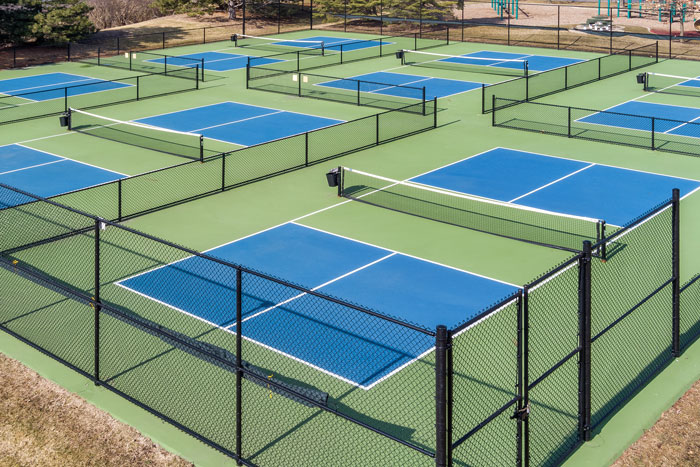Pickleball enthusiasts are making some noise—in more ways than one.
As the New York Post cleverly stated, “pickleball causes more of a racket than other racquet sports.” The rigid paddle and perforated plastic ball produce a noise that’s louder, more irksome and farther-reaching than the rebound of a fuzzy tennis ball off a stringed racquet. And since a pickleball court’s dimensions are smaller, hits during a rally are more rapid-fire than in tennis.
In major media outlets, people subjected to pickleball noise from nearby courts have described the near-constant, percussive pop-pop-pop as “borderline torture” (CNN), “like having a pistol range in your backyard” (The New York Times), and just plain “evil” (Philadelphia Magazine).
For some, the hyperbole is laughable. But responsible pickleball facility operators take noise complaints seriously. In
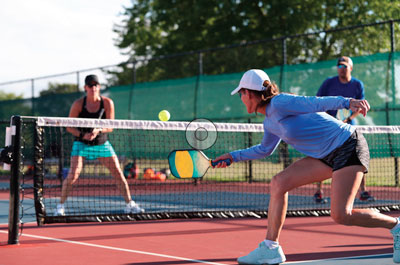
many cases, they have no choice, as excessive noise has led to lawsuits. (More on that later.) In other cases, they’re addressing noise before it ever becomes an issue. Problems tend to beget solutions, and pickleball operators now know that noise mitigation is possible through court location and design. In addition, manufacturers are making pickleball equipment designed to produce less noise. (Again, more on that later.)
The fact is, for many pickleball operators interviewed for this article, noise complaints from pickleball courts have seldom if ever been a problem. But what we learned—and stated right at the start—is that avid pickleball players are making noise in more ways than one. In communities all across the U.S., they’re creating another type of clamor, even when they’re not gripping a paddle. From blustery northern climes to the balmy southern states, players are banding together to demand more places and opportunities to enjoy their favorite pastime.
Pickleball for All
“Ninety-nine percent of the time, regardless of where you live, most pickleball players are the nicest people,” said Dan Brettschneider, recreation coordinator for the city of Savage, Minn.
The problem is that pickleball players are, indeed, underserved in many communities. After all, pickleball is America’s fastest-growing sport, with participation having skyrocketed by an astounding 223.5% in just three years, according to 2023 statistics compiled by the Sports and Fitness Industry Association (SFIA).
Due to budget limitations and previous experience with flash-in-the-pan recreational trends, many municipalities weren’t
quick to jump on the pickleball wagon, and now they’re scrambling to meet demand.
By all accounts, pickleball is here to stay. And it’s been around long enough that recreation managers looking to implement or expand pickleball offerings can benefit from the experience of established pickleball operations across the nation.
Pickleball, which combines elements of tennis, badminton and ping-pong, dates to 1965. The action is slower than tennis and the court is half the size, so for decades, pickleball was perceived as an older person’s pastime. Not so anymore. Pickleball participation in 2021 grew the fastest among players under 24, according to SFIA. This fall, Montgomery County Public Schools in Maryland became the first school system in the U.S. to offer pickleball as a varsity sport.
CNN attributes pickleball’s explosive growth to the pandemic, when stir-crazy folks of all ages sought out safe, socially distanced ways to congregate and exercise. But Brettschneider took note of pickleball’s broadening appeal a few years prior. More than 20 years ago, the city of Savage started marking, or “striping,” tennis courts for occasional pickleball use to appease a player population mostly made up of senior citizens. By 2015, and increasingly to the present day, “pickleball really took off and became a multigenerational pastime,” Brettschneider said, and as more pickleball players than tennis players began to use the courts, “residents were more vocal about wanting dedicated pickleball courts.”
It would take some time, but in 2021, Savage opened an eight-court dedicated pickleball facility. An additional four courts were completed this summer, for a total of 12 single-purpose pickleball courts.
Ready, Set, Grow!
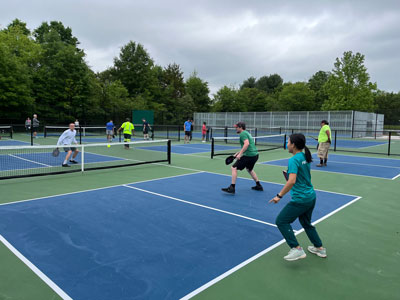
Every community’s pickleball journey has a different roadmap. But most have a similar starting point.
For Tampa, Fla., “Phone calls and emails were the start of it all,” said Heather Erickson, describing the genesis of the city’s now-robust pickleball program. Erickson, a longtime manager in the city’s parks and recreation department, oversaw a prodigious pickleball growth spurt that began in 2021 with nine courts. By the end of this year, the department will have completed 74 courts.
While the expansion over three years may seem swift, Erickson said the rollout was “slow and strategic, with the goal of converting certain spaces without eliminating other amenities. It was not a one-or-the-other approach.”
Pickleball’s rapid spread has challenged parks and rec departments to find ways to accommodate competing interests, often with limited space and funds. It’s common practice to convert existing tennis courts for dual use with pickleball, by adding lines and swapping out nets. This can lead to conflicts and complaints that pickleball is “taking over” tennis. But not on Erickson’s watch. Tampa is teeming with tennis players and boasts a pretty enthusiastic bunch of basketball players, as well. So, in the city’s effort to increase pickleball court inventory in accordance with public demand, “our approach was to consider all outdoor courts and open spaces with impervious pavement and lighting, including tennis, basketball and play courts, as well as open concrete areas in parks,” Erickson explained. “From there, we monitored the use and demand over time so as not to disrupt high-use sites.”
The department was able to draw from its annual court-resurfacing budget to create dual-use courts where appropriate, but “at no point did we convert a standalone amenity,” Erickson said. Conversions only occurred on sites with multiple courts, she added, and no more than half of the existing courts were ever converted, ensuring continued access to court sports besides pickleball.
“Another important aspect was to be sure that courts were spread around the city, providing equitable access to all neighborhoods,” Erickson said.
In Maryland, Montgomery County—a populous region adjoining Washington, D.C.—took a methodical approach to pickleball delivery, as well. In 2019, Montgomery Parks completed a sport court planning initiative involving various stakeholders whose multiyear efforts became known as “the pickleball study.” The popularity of pickleball—along with a budding interest in futsal (a soccer-like game played on a hard court)—prompted the county to explore how to use its oversupply of tennis courts.
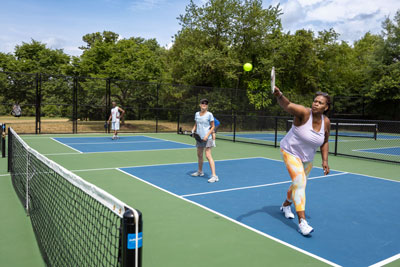
“The biggest outcome from that initiative was identifying how to offer pickleball without eliminating tennis,” said Chuck Kines, a park planner with the county.
Some underutilized tennis courts were repurposed as dedicated pickleball courts, but the majority of the county’s pickleball courts are shared with tennis. Adding pickleball lines to existing tennis courts is the easiest, quickest and most cost-effective way to increase the inventory of pickleball courts. “When you add pickleball lines to tennis courts, you’re not removing tennis from that facility; you’re just adding pickleball to it,” Kines said. “When you convert the tennis courts to pickleball, you are removing tennis, and so we’re very careful about where we do that. There are certain parks that we’ve identified as off-limits to pickleball because they’re so popular for tennis and they’re needed for tennis tournaments.”
The dual-use courts have painted lines for each sport’s dimensions. Pickleball players bring their own net or use the tennis net. For now, the shared courts are first-come, first-served facilities, but the county is rolling out a pilot program to allow people to reserve court time.
“Another way to deliver pickleball, which we’re not in a position to do yet, is to build brand-new, purpose-built pickleball courts from scratch,” said Kines, adding that “anytime there’s a shared court, there’s a potential for conflict.”
Input from a tennis pro who was part of the pickleball study guided the design of the shared courts, with the goal of satisfying both parties. “Something as simple as the color of the striping for one game can be highly distracting for the other game. At first, we were putting down yellow striping for pickleball, but we learned it was eliminating the enjoyment of tennis,” Kines said.
Subsequently, in deference to the tennis pro’s advice and in adherence with the U.S. Open’s standard court design, the county started using dark blue in-bounds areas with light blue pickleball lines.
Location, Location, Location
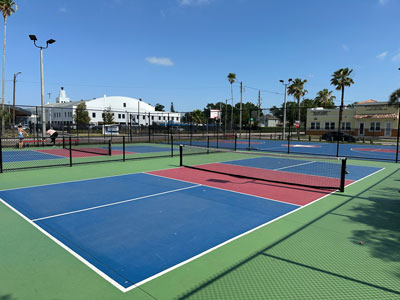
Preventing turf wars isn’t the only reason responsible park planners carefully consider where to place pickleball courts.
Dozens of lawsuits have been filed across the country against municipalities and homeowner associations because of the noise generated by pickleball facilities. Pickleball is noisier than tennis not just because of the harder paddle and ball but also because it fits more players into the same amount of space. And pickleball is a social sport, with more banter among players.
In Montgomery County, “We’re very careful about where we put pickleball based on distance from homes, because we had one location where it became a problem,” Kines said.
The trouble arose at one of the first pickleball facilities the county established. “It became very popular during the pandemic, and big groups were showing up from 6 a.m. to 11 p.m. because it was one of the only places to play. It was a pickleball magnet,” Kines said. “The problem was, there were homes less than 100 feet from the pickleball courts. And it wasn’t just the pickleball noise; it was the crowd noise, and people playing music. So, we learned from that experience and generally only put pickleball at locations no closer than 300 feet from homes.”
Well aware of the noise complaints occurring elsewhere, the city of Savage built their pickleball courts in a city park that sits on several acres and is nonadjacent to residential areas. “We’ll have people call and say, ‘Hey, why can’t you put a pickleball court in this neighborhood park right near our house?’ And we have a pretty easy answer: You don’t want pickleball that close to your house because of the noise,” Brettschneider said.
Sound engineers have determined that human hearing is especially sensitive to the sharp frequency and pitch of pickleball, which falls in the same range as the attention-grabbing beeping noise that big trucks make when they’re backing up.
USA Pickleball, the governing body of the sport, launched an initiative last year to address noise problems, working with manufacturers and facilities to come up with noise-muffling solutions including new paddle and ball materials, as well as noise-attenuating curtains for fencing. Following a 15-month study, USA Pickleball created a Quiet Category for pickleball products that reduce the sport’s sound output. It’s essentially an endorsement of products that deliver “50% or less of the acoustic footprint of equipment commonly sourced and used in community parks,” according to the organization’s website.
Several developers of noise-baffling systems, including the Kansas City, Kan.-based firm SLN/CR (pronounced “silencer”), also offer consulting services and guidelines for recreation managers. “Using specialized acoustics-management software, we simulate noise propagation to provide stakeholders with a clear understanding of the scope and scale of potential noise problems,” said founder and CEO Eliot Arnold. “We’ve also introduced a comprehensive framework called ‘Assess, Mitigate and Monitor,’ which helps cities systematically evaluate noise impacts, implement effective noise reduction measures and continuously monitor results to ensure community satisfaction.”
However, acoustic fence curtains are perhaps more accessible to country clubs than to cash-strapped parks and rec departments. While Montgomery County has fuller coffers than some other communities, “We have not experimented with acoustic curtains because we’d have to change our fencing and it’s very expensive,” Kines said. “In order to accommodate the weight of the acoustic curtain, the fence has to be engineered a certain way, and our existing courts aren’t designed to that standard.”
Kines is convinced that distancing pickleball facilities from homes is the most effective way to prevent noise complaints. However, this approach limits opportunities to provide pickleball in certain areas where people might like to walk to play. “So, we’re looking into potentially creating some pickleball courts in communities that have tennis courts with no lighting, so there wouldn’t be any nighttime play,” he said.
Let There Be Light
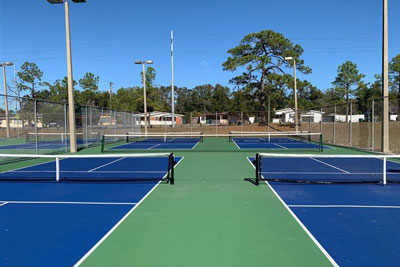
Montgomery County will conduct a pilot program to see if unlighted courts, limited to daytime use, can be closer to homes without causing noise complaints. Meanwhile, down in Tampa, Erickson will never again consider adding pickleball to a court with no lighting.
“We made a mistake early on. We had a grant for a six-court pickleball facility, our very first. But we didn’t have lights,” she said. “And let’s be honest. This is Florida. You want to play when the sun isn’t blaring down on you. So, the calls just came flooding in, with nonstop demand for lights. We learned from experience to expand courts only to areas that had current lighting. Adding a court to an area without lights leads to complaints, and finding funding for lighting is much more of a challenge than simply converting a surface.”
Bright lighting is a big draw for pickleball players. For recreational tennis courts, 30 footcandles is standard, while higher-level competition calls for 40 to 50 footcandles. The city of Savage sprang for 50 footcandles for its pickleball complex, at a cost of about $100,000 versus $85,000 for 30 footcandle lighting. “If you can come up with the money, it makes a world of difference,” Brettschneider said. “People always comment on how much better our lighting is compared to other facilities.”
Besides bright lighting, “There are some ingredients that make certain locations more attractive to pickleball players,” Kines said. “The first is bathrooms or porta potties—that’s probably the most important.”
ADA accessibility, adequate parking, shade structures, drinking fountains and the absence of nearby trees—which drop leaves, acorns and other debris onto courts—round out Kines’ list of “ingredients.”
Nice-to-have amenities could include picnic tables or bleachers where players can socialize, spectate or wait for their turn on the court. At facilities where tournaments and other organized events are held, electricity for running computers and playing music comes in handy, Brettschneider said. He also recommends wind screens for fencing—not so much to block the wind but to serve as a sort of “batter’s eye,” or solid-colored backdrop that allows players to track the ball more easily.
Programming and Events
Many programs run by parks and rec departments have an “open play” policy, which typically works well for pickleball players. That’s because they tend to be well-connected and well-organized, independently establishing channels of communication to arrange meetups. They form their own clubs and ladder leagues. They create their own Facebook pages and WhatsApp chat groups.
But you don’t have to be in a club to get in the game. Pickleball culture is known to be welcoming and inclusive. Beginners show up with inexpensive or borrowed paddles, Brettschneider said, “and they’ll find that most people are very welcoming and will help them with their game.”
And unlike tennis, “competence comes quickly” with pickleball, which “sits in the proverbial easy-to-learn but difficult-to-master sweet spot, and if you show up to a court with a paddle, you’ll probably find a game that suits you,” according to the online publication Thrillist.
“I’d say 99% of pickleball players get along with one another and share the courts, regardless of ability,” Brettschneider said. “If the courts are full and people are waiting to play, they’ll play one game and then the next people in line will hop on the court.”
With that said, experienced pickleball players can be fiercely competitive, and coordination of court use according to skill level helps ensure an enjoyable experience for everyone. Advanced players want to play against other advanced players, so some parks and rec departments that offer lessons and host tournaments apply a skill-level rating system to regular participants. In Tampa, though the courts aren’t reservable, advanced picklers prearrange to play at certain times and places without dominating the courts.
“Pickleball players, for the most part, self-regulate their play,” said Erickson, adding that court etiquette signs are posted at certain high-use facilities just in case.
The city of Savage is surrounded by other suburbs with serious pickleball leagues, so Brettschneider tailors his programming to suit a more casual, social dynamic. “Pickleball 101” classes are offered periodically, as are “Next Steps” clinics for players who want to take their skills to the next level. All are taught by a certified instructor.
The city also organizes a Friday morning “Friendly Doubles Mixer,” as well as occasional BYOB/P (bring your own bottle and paddle) event attended by more than 100 players. “It’s kind of a party atmosphere,” Brettschneider said. “We’ll bring out the speakers and play music. People usually bring food to pass around.”
Savage also hosts two three-day tournaments each year, drawing as many as 600 participants. But Brettschneider attributes the pickleball program’s success to its lack of overplanning and formality.
“We don’t run leagues where we’re taking up the courts four or five nights out of the week. We’re basically first come, first served, and that’s kind of our niche,” he said. “People drive here from surrounding communities to play on our courts because somebody’s programming their local courts all the time.”
If you build it, they will come. And if you build it right, they’ll come from far afield. “Our 12 courts in Savage are some of the most-used courts in the Twin Cities area, and it’s simply because we’ve invested the dollars to build nice courts that are well-maintained,” Brettschneider said. “People will come from 25 miles away just to play in Savage because they know they’re going to have a good court to play on and a good experience.” RM



